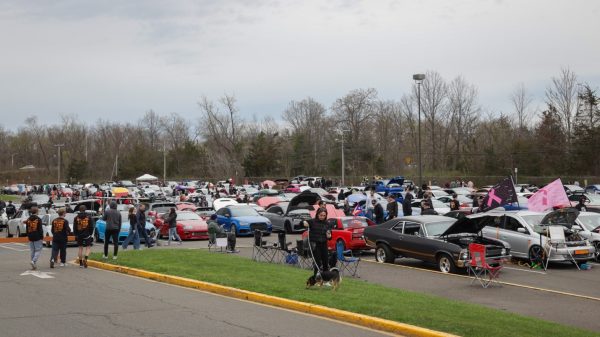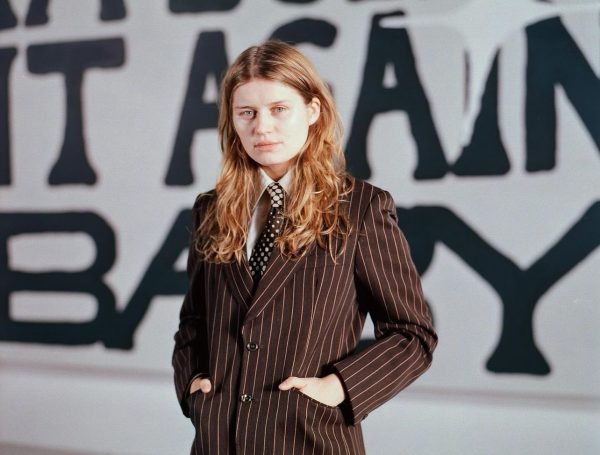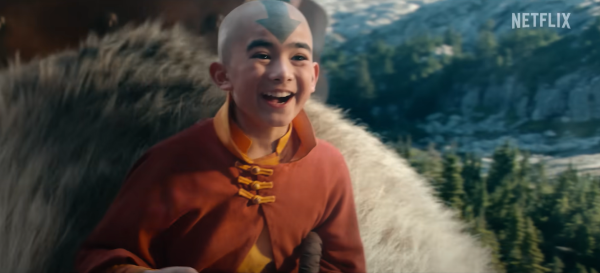Spending A Night With The Dead
October 25, 2018
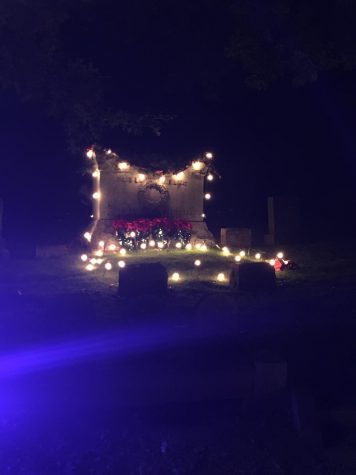
The grave of Elsie Traut is seen with Christmas decorations around it.

Philip Corbin tells the crowd about his companies.
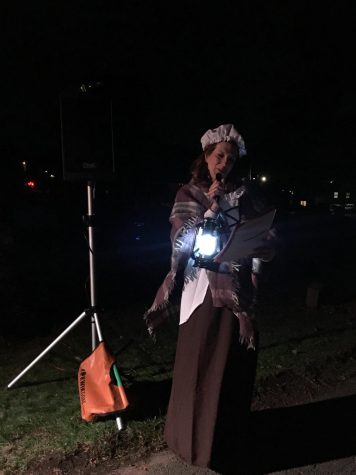
Tour guide Sara Lankton, sets up the story of the Klingbergs.
Halloween is almost upon us and in the spirit of all things spooky, what is better than spending the night walking through one of New Britain’s oldest cemeteries and learning about their most prominent residents? This is the tenth year of this walk and they tell the stories from past years. This year “Timeless Tales” told the audience about the lives of John Klingberg, Thomas Lynch, Philip Corbin, Elsie Traut and Sherman Avery.
The night began with our tour guide, Sara Lankton, telling the audience about the first person ever to be buried at Fairview Cemetery in 1756. Just about 38,938 residents reside here. She took wanderers to the first grave, Reverend John and Magdalene Klingberg.
The story of the Klingberg’s began with Mrs. Klingberg praying for her husband’s safe return from retrieving three homeless boys. These boys were found living in a shack all alone. When Mr. Klingberg got home, they discussed how they would feed everyone. Mr. Klingberg assures her that all will sort itself out. A week after the boys came to live with them, they were offered a bigger house and reduced rent. Many people got involved with the church. Over time the orphan children found homes. Mr. Klingberg however, had bigger plans. In 1920, the cornerstone for the Klingberg children’s home was laid. Today, it is a family center.
After leaving the Klingberg’s, the group went on to meet “the greatest umpire one could be,” Thomas Lynch. Lynch was the son of Irish immigrants. In the 1880s, umpires would face abuse. As an umpire it was his job to call those behaviors out — however, when he did he found himself in trouble.
Lynch prided himself on his fairness and honesty and keeping quiet about the mistreatment ended up hurting him deeply. After 13 seasons, he gave up being an umpire and came back to New Britain, becoming the Superintendent of New Britain Parks and Recreation. After that, he went into the advertising business. He still kept being an umpire “as long as it was for a good cause.”
Next was Philip Corbin. He is the namesake and reason for the existence of Corbin Avenue in New Britain. He founded the P and F Corbin Company, which specialized in decorative hardware: hooks, door knobs, etc. This hardware is featured in the capitol. However, he did not stop there. When he reached his 80s, he went into the automobile business and created the Corbin Model H touring car. However, two years after Corbin’s death, the company fizzled out. Corbin’s monument is the second tallest private headstone in all of America.
Now it was time to visit Elise Traut. Traut was of German descent, coming to America as a baby, arriving in New Britain in 1888. She was on the board that created New Britain General Hospital and stayed on the board for the rest of her life. She was well-known for being the most zealous lover of Christmas in New Britain. She even wrote a song, “The Christmas Tree Carol.” This love of Christmas helped her fund and found the tradition of the people’s Christmas tree in New Britain’s Central Park. She wanted a tree in New Britain after seeing poor children decorating a bush for Christmas — it was the closest thing they had to a Christmas tree.
To this day, each year a tree shows up in downtown New Britain. Her part ended with the group wishing her a “Merry Christmas” and Mrs. Traut wishing us a “Happy Halloween.” As the tour passed the graves of New Britain veterans, there was a moment of silence.
The final stop was Sherman Avery, the creator of Avery’s Soda. Avery was a lifelong resident of this town. He was originally in the milk industry, but then he began bottling products for Coca-Cola. However, Avery found himself bored with just dealing with one flavor. He wanted more flavors, especially his own. This is how Avery’s Soda came about. The original flavors were: cream soda, birch beer and ginger ale. Avery delivered soda door-to-door. He began with a horse-drawn wagon and eventually a delivery wagon. Prohibition helped his business in the first few years of its creation, especially during the Great Depression. Everyone on the tour was given a ticket that could be redeemed at the end of the tour for a complimentary bottle of Avery’s cream soda and remember always ask for Avery’s.
All in all, lots of history and stories were taught and told on the brisk Friday night. If you are into history, or just want something to do around Halloween, keep up with this event so you can get your tickets next year.







